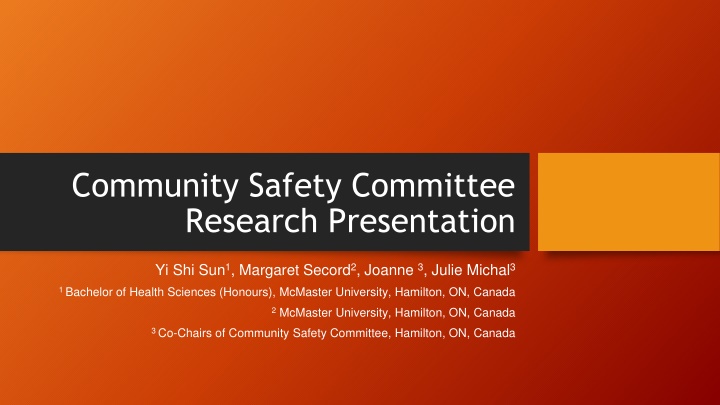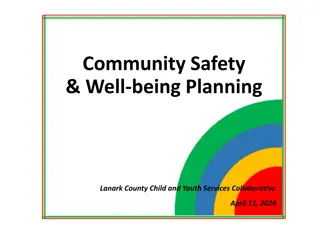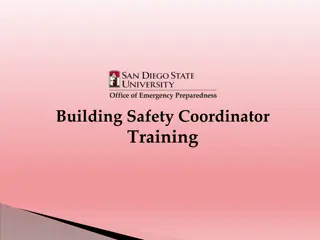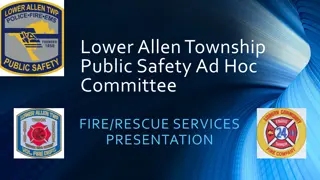
Enhancing Community Safety Through Participation Initiatives
Explore the spectrum of community participation initiatives for enhancing neighborhood safety in urban residential settings. Follow the research journey of the Community Safety Committee as they delve into strategies, timelines, and search methods to support their cause.
Download Presentation

Please find below an Image/Link to download the presentation.
The content on the website is provided AS IS for your information and personal use only. It may not be sold, licensed, or shared on other websites without obtaining consent from the author. If you encounter any issues during the download, it is possible that the publisher has removed the file from their server.
You are allowed to download the files provided on this website for personal or commercial use, subject to the condition that they are used lawfully. All files are the property of their respective owners.
The content on the website is provided AS IS for your information and personal use only. It may not be sold, licensed, or shared on other websites without obtaining consent from the author.
E N D
Presentation Transcript
Community Safety Committee Research Presentation Yi Shi Sun1, Margaret Secord2, Joanne 3, Julie Michal3 1 Bachelor of Health Sciences (Honours), McMaster University, Hamilton, ON, Canada 2McMaster University, Hamilton, ON, Canada 3 Co-Chairs of Community Safety Committee, Hamilton, ON, Canada
Research Question What is the spectrum of community participation and engagement initiatives that contribute to an increase in neighbourhood safety in an urban residential setting? Definition of Terms Spectrum: used to describe that there is a diverse range of focuses within the topic. For example, in the spectrum of community participation and engagement, there are informal activities such as socializing with neighbours, more formalized approaches such as neighbourhood watch, and everything in between. Initiative: A plan, strategy, or approach that can be used to improve a situation. For example, a community participation and engagement initiative is a plan, strategy, or approach with the focus on improving the community.
Timeline so far Month Activity August Community Safety Meeting (Aug 12, 2015), Brainstorming on Research Question September Community Safety Meeting (Sep 9, 2015), Creating the Research Question together and finishing paperwork October Community Safety Meeting (Oct 14, 2015), Creating Learning Contract/Action Agreement, Starting to explore the literature November Continued Research, Community Safety Meeting (Nov 11, 2015) December Continued Research, Progress Meeting with Ms. Margaret Secord (Dec 18, 2015)
Timeline so far (cont.) Month Activity January Continued research, Meeting with Ms. Julie Michal on status of the Community Safety Committee (Jan 7, 2016) February Continued research, Community Safety Meeting at SPRC (Feb 23, 2016) March Continued research, McMaster BHSc Poster Day (Mar 30, 2016) April Presentation with Community Safety Committee at SPRC (April 21, 2016) May and Onwards Continued research and support of Community Safety Committee
Search Strategy Academic databases: Google Scholar Journals @ Scholars Portal Social Science Abstracts Sociological Abstracts JSTOR (Journal Storage) Grey literature: Canadian Public Policy Collection LexisNexis Canadian Federal Website Various Municipal and Provincial Websites
Items to Consider Throughout Coherence How does this initiative relate to other things that are going on in the community? Deliberateness What are the initiative s specific objectives? Inclusiveness How well does the initiative address all components of the problem it is designed to solve? Theoretical Comprehension What background research has gone into the design of this initiative?
Items to Consider Throughout (cont.) Adequacy of Scope and Rigour How well does this initiative affect all the factors that are contributing to the problem? Measurability How will you know if the initiative is achieving the desired results? Sustainability Where will the interest, energy, and resources come from to sustain the initiative? How easy will it be to keep the initiative going? Gaining Momentum Multi-Sector Community Safety and Well-being in Ontario (2015)
Significance of Community Engagement The most successful crime prevention initiatives are comprehensive. The causes of crime are very complex and there are no simple solutions. Rather than relying on a single program or strategy, you should use several different programs that are targeted at different aspects of the problem Programs using a collaborative approach and addressing root problems have been very successful. Delivering local solutions to local problems that have been identified by local people. Focus on prevention, crisis intervention, and long-term solutions. Premier's Advisory Council on Crime and Community Safety: Final Report (2015) Making Cities Safer Action Briefs for Municipal Stakeholders (2009)
Challenges to Community Engagement Not enough volunteers Leading to other community volunteers becoming burned out Perceived increased liability, risk and high stress levels in volunteer roles Community buy in through education and awareness No coordination within communities about what types of programs are being offered by whom Organizations working in silos Lack of system support, core funding, and staff Need to build community capacity Developing train-the-trainer programs and providing support for volunteers Notes Premier's Advisory Council on Crime and Community Safety Final Report (2015)
Different Strategies Researched in the Literature Neighbourhood Watch Social Cohesion Surveillance Lighting Image and Maintenance Territoriality Activity Support Access Control Crime prevention through environmental design (CPTED) Sustaining Volunteer Engagement Target Hardening Situation Table
Social Cohesion Domains Local Policies to Enhance the Domains Empowerment Giving local people voice, Giving local people a role in policy processes Participation Establishing and supporting local activities, organisations, and events Common purpose Cooperating with one another, developing and supporting networks Supporting networks Expectation that help would be given to or received from others when needed Collective norms and values Ethos which residents recognise and accept, promoting community interests Trust Encouraging trust in residents in their relationships, bringing conflicting groups together Safety Involvement in local crime prevention, providing visible evidence of security measures Belonging Boosting the identity of a place via design, street furnishings, naming Social cohesion, social capital and the neighbourhood (2001)
Social Cohesion (cont.) Important for neighborhood development Contributes a sense of individual and group empowerment that helps neighbors to collectively act to meet their shared needs Social cohesion can be a significant predictor of actual involvement in crime prevention efforts by local community-based organizations Extent to which neighbors share values Can rely on each other for support Sense of community in the urban environment A catalyst for participation and community development (1990) An Examination of Citizen Involvement in Crime Prevention in High-Risk Versus Low- to Moderate-Risk Neighborhoods (2006) Act in ways that protect the safety of their communities
How to Build on Domains of Social Cohesion? Initiatives and programs varies by neighbourhood No one model fits all approach Examples: Hold focus groups/consultations with residents, stakeholders, vulnerable populations to identify needs within a community and develop a strategy to address those needs (housing, safety, etc) Work with local business associations to develop strategies that match jobs to existing residents skills and employment needs Community mapping exercise to identify safe common meeting locations in the community Increased recreation, cultural and community-based programming in public areas such as parks
How to Build on Domains of Social Cohesion? Examples: Locally led street/block parties and community festivals that celebrate the community s diversity Community based methods of support: babysitting clubs, walking groups, food cooperatives Victoria, Australia local government action guides - Increasing social connections (2012) Simcoe Muskoka District Community Design Social Cohesion & Well-being (2015)
Social Cohesion (cont.) Social cohesion was the strongest predictor of involvement in both high- risk and low- to moderate-risk neighborhoods In high-risk neighborhoods, the following three factors emerged as significant predictors of citizen involvement: a) Residents who felt like part of the neighborhood (versus just a place to live) b) Minority residents were more likely to be involved c) Residents who believed that police get to know residents Social cohesion a robust predictor of lower rates of violence An Examination of Citizen Involvement in Crime Prevention in High-Risk Versus Low- to Moderate-Risk Neighborhoods (2006) Neighborhoods and violent crime: A multilevel study of collective efficacy (1997)
Neighbourhood Watch Not standardized, varies among implementation Common themes: a) residents operating as the eyes and ears of the police b) residents reporting suspicious behavior to the police or neighborhood coordinator c) residents interacting and working together to solve problems Different goals in different neighbourhoods: reduce fear of crime, increase informal neighbourhood control of minor crimes, increase public confidence in police NOT to make citizen s arrests, nor take any action that might jeopardize volunteers safety or that of the public The Effectiveness of Neighborhood Watch A Systematic Review (2008)
Neighbourhood Watch (cont.) The results of the narrative review show that 19 of the 24 evaluations included in the analysis found that neighborhood watch was associated with a reduction in crime. The Effectiveness of Neighborhood Watch A Systematic Review (2008)
Neighbourhood Watch (cont.) Deterrent effect on the perceptions and decision making of potential offenders Visible surveillance Perceptions of potential offenders in terms of their likelihood of getting caught Creation of signs of occupancy Generation of acceptable norms of behavior and by direct involvement of residents Enhance community cohesion Increase the flow of useful information from the public to the police Greater number of arrests and convictions Does neighborhood watch reduce crime A systematic review and meta-analysis (2006)
Neighbourhood Watch (cont.) Lack of data and inconclusive research on community participation levels within Neighbourhood Watch engaging in neighbourhood surveillance, social interaction, etc Possibility that Neighbourhood Watch activities may increase fear of crimes and racial prejudice Especially in non-homogenous populations Social-control processes have little influence over outsiders who feel no pressure to conform Residents have little leverage to regulate or change the social perceptions and behaviors of outsiders The theory and research behind neighborhood watch Is it a sound fear and crime reduction strategy (1987)
Surveillance Physical design can promote informal or natural surveillance opportunities for residents If offenders perceive that they can be observed, they may be less likely to commit the offense Increased potential for intervention, apprehension, and prosecution Natural: residents self-surveillance opportunities, windows Organized: security guards, patrols Mechanical: closed circuit television surveillance Crime prevention through environmental design (CPTED) a review and modern bibliography (2005)
Surveillance (cont.) Burglars avoid targets that are readily observed by neighbours Concealment opportunities for burglars Properties with low levels of lighting High walls and fences Thick foliage Linear integrated spaces with strong intervisibility of good numbers of entrances provide more surveillance opportunities Existence of natural surveillance opportunities does not mean surveillance is taking place or any direct action by citizens is guaranteed Burglary of Single-Family Houses (2002) A place for every crime and every crime in its place: an alternative perspective on crime displacement (1992)
Surveillance (cont.) Suburban Vancouver: Increased formal bike patrols at parking lots and garages have demonstrated reductions in car-related crime London Underground: Reduced robberies and car-related crime with closed circuit television security compared with a control group in parking lots Burnley, United Kingdom: implementation of closed circuit television security significantly decreased all recorded property crime Burglary, car crime, criminal damage, and stolen goods Preventing auto theft in suburban Vancouver commuter lots: effects of a bike patrol (1996) Understanding Car Parks, Crime and CCTV: Evaluation Lessons from Safer Cities (1993) An Evaluation of Secured by Design Housing Schemes Throughout the West Yorkshire Area (1999)
Lighting Two theories on why improved street lighting may cause reduction in crime Increased surveillance of potential offenders improving visibility and by increasing the number of people on the street predicts decreases in crime especially during the night-time Increased community investment in the area increased community pride, community cohesiveness and informal social control decreases in crime during both day-time and night-time Effects of improved street lighting on crime a systematic review (2002)
Lighting (cont.) Meta-analysis of 13 studies (8 American, 5 United Kingdom) showed that improved lighting led to reductions in crime Overall reduction in crime after improved lighting was 20% Did not find that night-time crime decreased more than day-time crime Supports theory of improved street lighting reducing crime because of its role in increasing community pride and community investment Most effective in reducing crime in stable homogeneous communities Effects of improved street lighting on crime a systematic review (2002)
Crime Prevention Through Environmental Design (CPTED)
Crime Prevention Through Environmental Design (CPTED)
Territoriality Reinforcing sense of ownership in legitimate users of space Reducing opportunities for offending by discouraging illegitimate users Design that differentiates between private property and public spaces Yard/driveway/walkway VS street/sidewalk Methods of differentiation: shrubbery, bushes, alternate paving stone colour Residential burglars judge risk The role of territoriality (1993) "Crime Prevention Through Environmental Design - Royal Canadian Mounted Police". Rcmp-grc.gc.ca. N.p., 2011. Web. 21 Apr. 2016.
Territoriality (cont.) In study with 72 incarcerated burglars, most burglars factored territorial concerns, neighbor reactivity, and difficult entry into their judgments that a house was burglarized or not burglarized Though territoriality has shown to be most effective at the local level Difficulties associated with definition, interpretation and measurement Varies between cultures, neighbourhoods, and individual groups Residential burglars judge risk The role of territoriality (1993) Defensible space undefended: social factors in crime prevention through environmental design (1981) Suburb Boundaries and Residential Burglars (2003)
Activity Support The use of design and signage to encourage intended patterns of usage of public space Encourage residents use and presence in local parks, paths, and alleyways Increased numbers of pedestrians may provide surveillance and potentially discourage some offences May encourage other targets for crime (i.e. pick-pocketing) Crime Prevention Through Environmental Design: Applications of Architectural Design and Space Management Concepts, 2nd ed.
Access Control Focused on reducing opportunities for crime by: denying access to potential targets creating a heightened perception of risk in offenders Can comprise many forms: Informal and natural: spatial definition Formal and organised: security personnel Mechanical strategies: locks and bolts Areas with unregulated access have more crime than areas with street layouts with more restricted access Defensible Space: People and Design in the Violent City (1971) Preventing Crime: What Works, What Doesn t, What s Promising (1997)
Access Control (cont.) New York s Bronx district: routes through the public housing complex were reduced in number, lighting and surface appearance of the buildings was improved Significant reduction in crime (54%) was reported (no control group) Creating Defensible Space (1996)
Support and Target Hardening Increases the efforts that offenders must expend for a crime Long-established and traditional approach to crime prevention Denying or limiting access to a crime target through the use of physical barriers (fences, gates, locks, electronic alarms, and security patrols) UK public housing estates: target-hardening strategies resulted in reductions in burglaries (control group used in comparison) Burglary Reduction: Findings From Safer Cities Schemes (1994) Residential security: containment and displacement of burglary (1984)
Alley-gating Installation of lockable gates across the alleyways on the rear of properties Situational crime prevention with widespread popularity in the UK Keys to the gates provided only to residents who live in the houses secured by the gates Critics have compared it to gated neighbourhoods Alley-gating does not physically create a closed-off community within gates, since only the alleys to the back are enclosed Before (Jan 1998 - Dec 1999) After (Jan 2000 - June 2003) Total of 3178 gates were installed Closing off opportunities for crime: An evaluation of alley-gating (2005) Alley-gating and neighbourhood gating are they two sides of the same face (2003)
Support and Target Hardening (cont.) Excessive use of target hardening tactics can create a fortress mentality Second-generation CPTED in schools (1997) Self-policing capacity of the built environment is damaged Imagery whereby residents withdraw behind physical barriers
Image and Maintenance Broken windows theory : demoralizing effect that abandoned buildings, graffiti, and general decay have on neighbourhoods Promoting a positive image and routinely maintaining the built environment Management of private rental housing can reduce drug related crime Routine maintenance of the urban environment will significantly assist in reducing crime New York Port Authority Bus Terminal: goal to reduce disorder and crime 62 tactics used including focus on renovations, visibility, surveillance, and flow Reductions in order complaints and robbery and assault offenses Preventing Crime at Places: Why Places Are Important (1997) From Broken Windows to Busy Streets: A Community Empowerment Perspective (2015) Redesigning Hell: Preventing Crime and Disorder at the Port Authority Bus Terminal (1996)
Crime prevention through environmental design RCMP: Research has shown that the proper design and effective use of the built environment can lead to a reduction in both the opportunity for crime and fear of crime Incorporation into local crime prevention plans of Toronto and Edmonton Application in the design of neighbourhoods, parks, public housing, etc in Erin Mills, Vancouver, Lethbridge, Brampton, Kitchener "Crime Prevention Through Environmental Design - Royal Canadian Mounted Police". Rcmp- grc.gc.ca. N.p., 2011. Web. 21 Apr. 2016.
Crime prevention through environmental design (cont.) Five Oaks project in Ohio: reported a 26% decrease in recorded crime after a range of CPTED interventions multiple interventions obscure the detailed understanding of what each intervention contributed Britain and North America: analysis of 45 cases of environmental design and improvement: 24 with evidence of crime reduction and another 12 with positive findings Focus on lighting, fencing, improving surveillance, neighbourhood cleanup, and physical improvements to housing Creating Defensible Space (1996) What Works in Crime Prevention: An Overview of Evaluations (1993)
Crime prevention through environmental design (cont.) Most successful in cases when residents are made aware of and educated upon the design strategies that have been implemented and their role in maximising the potential of these strategies More positive cases included: Lighting, fencing, improved surveillance, clean up of neighbourhoods Street changes, wider market gangways What works in crime prevention: an overview of evaluations (1993) Planning For Crime Prevention: A Transatlantic Perspective (2002)
Crime prevention through environmental design (cont.) Irrational offenders (i.e. intoxicated) are less likely to be deterred Social conditions may nurture fear, reduce inclination to intervene, and result in withdrawal of residents into their home Implementation of crime prevention measures in one area can displace existing crime to another location, target, type of crimes Fortress mentality can result Citizens and neighbourhoods withdraw behind walls, fences, and fortified homes Marginalized members of the community are other-ed An introduction to 2nd Generation CPTED (2003), Crime Spillover (1981)
Situation Table Regular held meeting with police, representatives from different community organizations, and community members to discuss risk situations in a timely matter By addressing situations with acutely elevated risk and/or individuals at imminent risk of harm and victimization, the Situation Table can work together to intervene Relatively new program and as of March 2015, there are currently 8 pilot Situation Tables operating across Ontario with 6 more planned A study detailing the results of the pilots has yet to be released Presented by the Minister of Community Safety and Correctional Services at the summit on Economics of Policing Community Safety Reported that the North Bay Gateway Hub Situation Table has 200 cases brought forward in a year s time with 290 individuals supported "Public Safety Canada - 2Nd Summit On The Economics Of Policing & Community Safety - March 2, 2015 - Ottawa". news.ontario.ca. N.p., 2015. Web. 21 Apr. 2016. "Situation Table Helps Those In Need". Beacon Herald. N.p., 2016. Web. 21 Apr. 2016. "Situation Table Training, Centre For Public Safety And Well-Being | Wilfrid Laurier University". Wlu.ca. N.p., 2016. Web. 21 Apr. 2016.
Evaluation of Situation Tables in Cambridge and Kitchener Cambridge: first 13 months, 105 situations discussed Kitchener: first 5 months, 35 situations discussed 25 members representing local services and organizations Alternate members to stand-in when primary representative was unavailable Most common risk factors: mental health, criminal involvement, and substance use Key factor to successful implementation: recruitment and engagement of members with the ability to act quickly with flexibility and autonomy in their home organizations in response to situations An Evaluation of the Connectivity Situation Tables in Waterloo Region Addressing Risk Through System Collaboration (2015)
Evaluation of Situation Tables in Cambridge and Kitchener Connect individuals/families in situations with services in 76% of situations When comparing police linked calls in 90 days prior to 90 days after the situation has been closed by the Situation Table 74% reduction in police linked calls associated with individuals involved in the situation The Situation Table has assisted local services to reach vulnerable populations that they have had difficulty connecting with Positive impact on local services as well as the relationships between services and organizations involved in the Situation Table An Evaluation of the Connectivity Situation Tables in Waterloo Region Addressing Risk Through System Collaboration (2015)
How to move forward? Online Situation Table Training Centre for Public Safety and Well-Being is proud to present this Situation Table learning package designed for police services and community partners who are considering risk- driven collaborative interventions to increase community safety and well-being. Includes: Training Modules, Videos, Manual, and Other Resources https://www.wlu.ca/academics/faculties/faculty-of-human-and-social-sciences/centre- for-public-safety-and-well-being/situation-table.html 2016-18 Safer and Vital Communities Grant Though the deadline for applications has passed, Fionne Yip from the Ministry of Community Safety and Correctional Services may be a resource to contact for additional opportunities and to connect to other developing Community Safety programs http://www.mcscs.jus.gov.on.ca/english/Policing/ProgramDevelopment/SVC201618.html
Capacity of an Organization Role Specification How clearly is the role defined? Dissemination How is information of the role provided to the public? Role Availability How available are these opportunities? Role Flexibility How adjustable are the demands of the role? Cash Are participants being paid for work in cash? Compensation Engaging older adults in volunteering: Conceptualizing and measuring institutional capacity (2008)






















